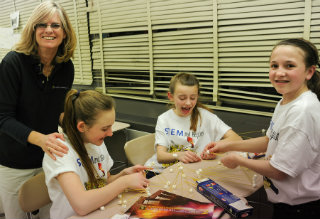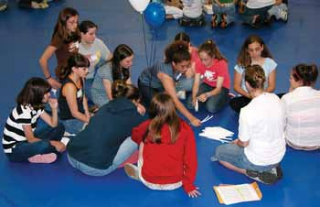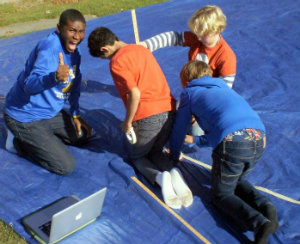STEM Programs Must Not Leave Math Behind!
A MiddleWeb Blog

Don’t Leave Math (or Math Teachers) at the STEM Starting Gate
by Susan Pruet
Several of Anne Jolly’s blogs this year gave us all good tips on what to look for in a quality STEM lesson or project. What is really exciting for me is seeing more and more lessons appearing on the web that meet most of Anne’s recommendations. However, the one criteria that seems to be lacking more often than the others is that these lessons should “integrate and apply science and math grade level objectives.”
The lessons I’m seeing are strong on having teams design and create innovative technologies to solve real and compelling problems, and usually do a good job of integrating science, engineering and technology. But, it seems that rarely do these STEM lessons involve math teachers or meaningful math content, especially in the middle grades.
What’s more, many of lessons that do claim to integrate mathematics do so in fairly superficial ways that involve more arithmetic than mathematics (e.g., budgeting a project); or they integrate fairly simple math (e.g. drawing a graph of data gathered or computing averages of data). These applications are important, but they do not involve bigger middle grades math ideas, such as proportional reasoning or statistical variance. And they don’t seem to be all that engaging for middle grades students.
Why math matters

I’ll draw on my background as a middle grades math teacher and teacher educator, and more recently as the founding director of a middle grades integrated STEM program in Mobile, Alabama called Engaging Youth through Engineering (EYE). This workforce and economic development program used engineering design challenges and the engineering design process to support grade level math and science “big ideas” versus using STEM to primarily teach engineering concepts.
The goal for this upper elementary and middle school program was to bring rigor and relevance to “school” math and science through integrated STEM curriculum. In that way we hoped that students would choose to take more STEM courses in high school as preparation for STEM careers. For those of you who have not been following Anne’s earlier blogs about this EYE curriculum and its development in Mobile, you can get more background by contacting Melissa Dean (mdean@maef.net) who currently directs EYE.
So, why do I feel so strongly about including math and math teachers in STEM? I discussed this topic in depth as part of an article on Revisiting the STEM Problems and Why STEM Must Not Leave Math or Math Teachers Behind last fall in Wayne Carley’s STEM Magazine (Find the full article here – pages 28-42.) I’ll just touch on the high points here.
We have all read and heard about the “STEM problem:”
The United States is not producing enough gradates in STEM fields – at the technical, four year, or graduate levels – who are both eager and able to fill our country’s growing demand for STEM-savvy workers.
The “math effect”

This “math effect” unfortunately carries over to all STEM fields. Jo Handelsman, a microbiologist at Yale and one of the authors of the President’s Council of Advisors on Science and Technology’s report, Engage to Excel (2012), highlights the finding that “math was the single biggest barrier to training STEM majors.” Another study points out that succeeding in the sciences in colleges depends more on the number of high school math courses students take than on whether students have had physics, chemistry, or biology. The message: To be successful in college-level science, students should take more high school math! (Tai and Sadler, 2007).
Include math in STEM’s active learning
Dr. Handelsman also pointed out that teaching strategies that involve active learning and make mathematics more relevant are the key to improving both performance and interest in mathematics. That exactly describes teaching and learning associated with integrated STEM lessons and projects. And this type of teaching and learning is consistent with the description of the mathematical practices in the Common Core State Standards for Mathematics (CCSS) currently guiding K-12 math curriculum in most states. These and other reports, coupled with my own experience, serve to support my claim:
STEM education must not leave mathematics or math teachers behind.
I firmly believe our math teachers themselves could prove to be a powerful resource in producing enough graduates eager and able to pursue STEM careers. Math teachers, especially at the middle grades, have daily contact with every single youngster. This allows them ample opportunity to positively influence our youth’s STEM capabilities, as well as their attitudes and beliefs toward mathematics and STEM careers.
Supports for math teachers
But math teachers cannot be expected to do this alone. They need resources, support, and professional development. They need quality, integrated STEM curriculum with meaningful math applications that energize and bring relevance to grade-level mathematics.

Even with good STEM curriculum, teaching math concepts through integrated STEM investigations requires different materials and additional classroom support. Many STEM units require significant changes to “math-as-usual” instruction. They involve more active classrooms and different strategies to, for example, manage teams and materials.
Often extra pairs of hands are needed to help with some labor-intensive lessons. (This is a great opportunity to engage volunteers from your community, higher education community, and/or any STEM-related industries! But teachers often need support in securing and managing these volunteers.)
Teachers need to “go deep”
One last, but important consideration: teachers must often think more deeply about the mathematics involved in order to apply it to a STEM design challenge. They must be able to guide students as they design and test innovative solutions to the design challenges. STEM applications that bring relevance to grade level math are not the typical applications that math teachers are accustomed to – and more comfortable with – teaching.
Math teachers need time to prepare to use integrated STEM that brings both rigor and relevance to math content. They need quality and targeted professional development related to “what, why, and how” of integrating STEM in support of mathematics.
Math teachers: keys to STEM success
I firmly believe that using truly integrated STEM with our students can support the learning of meaningful mathematics and showcase both the beauty and practicality of math in the world around them. Our math teachers are in a prime position to be a positive influence on both our middle grades students’ attitudes toward mathematics and their interest in pursuing STEM careers.
The bottom line is: given quality STEM curriculum, and the needed resources and support, our math teachers themselves can prove to be a key and powerful resource in producing graduates eager and able to pursue STEM careers.
I look forward to sharing in a later post some ideas for what mathematics is particularly well-suited for STEM projects.
References
• President’s Council of Advisors on Science and Technology (PCAST). (2010). Prepare and Inspire: K-12 Science, Technology, Engineering, and Math (STEM) Education for America’s Future. Downloaded from www.whitehousegov/ostp/pcast
• President’s Council of Advisors on Science and Technology (PCAST). (2012). Engage to excel: Producing one million additional college graduates with degrees in Science, Technology, Engineering, and Mathematics. Downloaded from www.whitehousegov/ostp/pcast
• Sadler, Phillip. M., and Tai, Robert (2007). Two high school pillars supporting college science. Science 317 (5837), 457-458.
Dr. Susan Pruet is President of STEMWorks LLC and served as principal investigator for the Mobile Area Education Foundation for 13 years, during which time she led a multimillion-dollar NSF grant to develop STEM curriculum for the middle grades. She enjoys using her expertise to work with districts in developing STEM and Leadership Development programs. Contact her at susan.stemworks@gmail.com.



































Incredible short-sightedness while using the term “integrated” and “STEM” without even mentioning the complete and utter failure of supposed “real teachers” (core teachers) who have never once stepped outside their realm to see a high-functioning CTE program deliver STEM concepts via Career and Technical Education classes such as Technology Education, Business Education, or Engineering and Design classes.
Having been in the CTE lab over two decades, I have only had two math teachers and one science teacher even bother to venture down to my end of the hallway since I am but a “preparation time” for them. If you really want “Integration” how about putting a class whose sole purpose is design and problem-solving directly in the core schedule so students can actually learn by doing instead of struggling to connect the dots of a Common Core segmented world.
Shame, shame SHAME on educators who who live inside their own little curriculum space to the detriment of their own self-interests! One would only need look to bridge/tower design, windmill structures, mag-lev or CO2 prototype and modeling to see fine examples of proportional reasoning and statistical variance. Get out of the classroom during your prep period and go meet your peers! New friends may help you bring more to the STEM table!
Hi, Bart – I can sense your frustration. Check out my February CTE post – Where Career Tech Meets STEM Education (http://bit.ly/1L8TQnM).
You’re certainly right about the great fit between CTE and STEM. The CTE teachers could take the initiative in setting up a meeting with the science and math teachers and explaining how their work fits with the STEM program and (hopefully) with the current science and math objectives which those teachers must be careful to teach. Or at least, host a discussion about how this might work for teaching STEM.
Teacher collaboration is really necessary to prepare students well for any field, and for the STEM field in particular. CTE is a big “plus” toward accomplishing that in schools where it’s offered.
Thanks for raising our awareness of the need for this.
I understand that science applications become a foundation for competitive learning. I like how you mentioned that Integrated STEM can help students have a more in-depth view of their role in the world. Today’s students are tomorrow’s pioneers. Occupations in STEM-related professions are probably the quickest developing and best paid of the 21st century, and they frequently have the best potential for work development. The most ideal approach to guarantee future achievement and life span is to ensure that the students are well versed in these subjects.